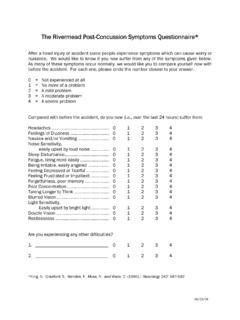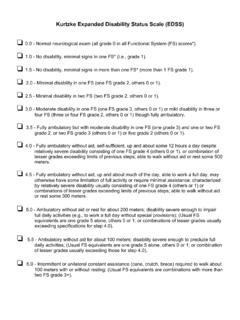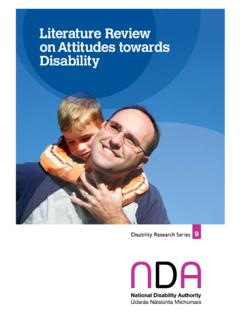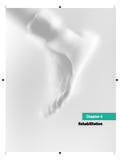Transcription of Glasgow Outcome Scale - TBI-IMPACT.org
1 Glasgow Outcome Scale The Glasgow Outcome Scale (GOS) is a global Scale for functional Outcome that rates patient status into one of five categories: Dead, Vegetative State, Severe disability , Moderate disability or Good Recovery. The Extended GOS (GOSE). provides more detailed categorization into eight categories by subdividing the categories of severe disability , moderate disability and good recovery into a lower and upper category: Table 1: Extended Glasgow Outcome Scale (GOSE). 1 Death D. 2 Vegetative state VS. 3 Lower severe disability SD - 4 Upper severe disability SD +.
2 5 Lower moderate disability MD - 6 Upper moderate disability MD +. 7 Lower good recovery GR - 8 Upper good recovery GR +. Use of the structured interview is recommended to facilitate consistency in ratings. References: Jennett B, Bond M: Assessment of Outcome after severe brain damage. Lancet 1:480 484, 1975. Teasdale GM, Pettigrew LE, Wilson JT, Murray G, Jennett B. Analyzing Outcome of treatment of severe head injury: A. review and update on advancing the use of the Glasgow Outcome Scale . Journal of Neurotrauma 1998;15:587-597. Wilson JTL, Pettigrew LEL, Teasdale GM.
3 Structured interviews for the Glasgow Outcome Scale and the Extended Glasgow Outcome Scale : Guidelines for Their Use. J Neurotrauma 15(8): 573-85. 1997. Wilson JT, Slieker FJ, Legrand V, Murray G, Stocchetti N, Maas AI. Observer variation in the assessment of Outcome in traumatic brain injury: experience from a multicenter, international randomized clinical trial. Neurosurgery. Jul;61(1):123-8;. discussion 128-9. 2007 . Recommended time for assessment: Basic Intermediate Advanced 3 months Outcome X X. 6 months Outcome X X X. 12 months Outcome X.
4 POST DISCHARGE. STRUCTURED INTERVIEW FOR GOSE. Respondent: 0 = Patient alone 1 = Relative/friend/caretaker alone 2 = Patient plus relative/friend/caretaker Conciousness: 1. Is the head-injured person able to obey simple commands or say any words? Yes No (VS). Note: anyone who shows the ability to obey even simple commands or utter any word or communicate specifically in any other way is no longer considered to be in vegetative state. Eye movements are not reliable evidence of meaningful responsiveness. Corroborate with nursing staff and/or other caretakers.
5 Confirmation of VS requires full assessment. Independence at home: 2a. Is the assistance of another person at home essential every day for some activities of daily living? Yes No (VS) If no: go to 3. Note: for a NO answer they should be able to look after themselves at home for 24 hours if necessary, though they need not actually look after themselves. Independence includes the ability to plan for and carry out the following activities: getting washed, putting on clean clothes without prompting, preparing food for themselves, dealing with callers and handling minor domestic crises.
6 The person should be able to carry out activities without needing prompting or reminding and should be capable of being left alone overnight. 2b. Do they need frequent help of someone to be around at home most of the time? Yes (lower SD) No (upper SD). Note: for a NO answer they should be able to look after themselves at home up to eight hours during the day if necessary, though they need not actually look after themselves 2c. Was the patient independent at home before the injury? Yes No Independence outside home: 3a. Are they able to shop without assistance?
7 Yes No (upper SD). Note: this includes being able to plan what to buy, take care of money themselves and behave appropriately in public. They need not normally shop, but must be able to do so. 3b. Were they able to shop without assistance before? Yes No 4a. Are they able to travel locally without assistance? Yes No (upper SD). Note: they may drive or use public transport to get around. Ability to use a taxi is sufficient, provided the person can phone for it themselves and instruct the driver. 4b. Were they able to travel locally without assistance before the injury?
8 Yes No Work: 5a. Are they currently able to work (or look after others at home) to their previous capacity? Yes If yes, go to 6 No 5b. How restricted are they? a. Reduced work capacity? a. (Upper MD). b. Able to work only in a sheltered workshop or b. (Lower MD). non-competitive job or currently unable to work? 5c. Does the level of restriction represent a change in respect to the pre-trauma situation? Yes No Social and Leisure activities: 6a. Are they able to resume regular social and leisure activities outside home? Yes If yes, go to 7 No Note: they need not have resumed all their previous leisure activities, but should not be prevented by physical or mental impairment.
9 If they have stopped the majority of activities because of loss of interest or motivation, then this is also considered a disability . 6b. What is the extent of restriction on their social and leisure activities? a. Participate a bit less: at least half as often as before injury a. (Lower GR). b. Participate much less: less than half as often b. (Upper MD). c. Unable to participate: rarely, if ever, take part c. (Lower MD). 6c. Does the extent of restriction in regular social and leisure activities outside home represent a change in respect or pre-trauma Yes No Family and friendships: 7a.
10 Has there been family or friendship disruption due to psychological problems? Yes No If no, go to 8. Note: typical post-traumatic personality changes are: quick temper, irritability, anxiety, insensitivity to others, mood swings, depression and unreasonable or childish behaviour. 7b. What has been the extent of disruption or strain? a. Occasional - less than weekly a. (Lower GR). b. Frequent - once a week or more, but not tolerable b. (Upper MD). c. Constant - daily and intolerable c. (Lower MD). 7c. Does the level of disruption or strain represent a change in respect to pre-trauma situation?











